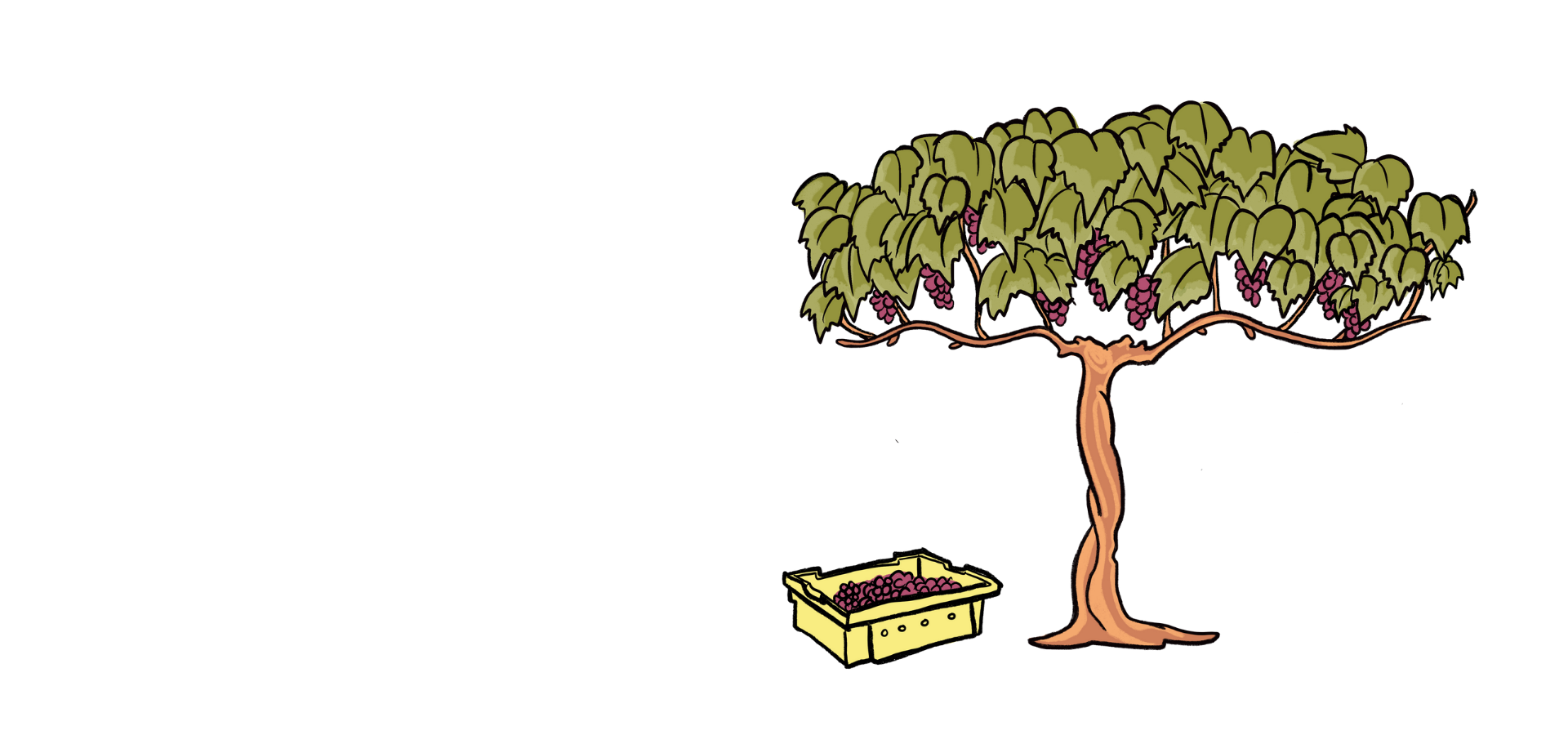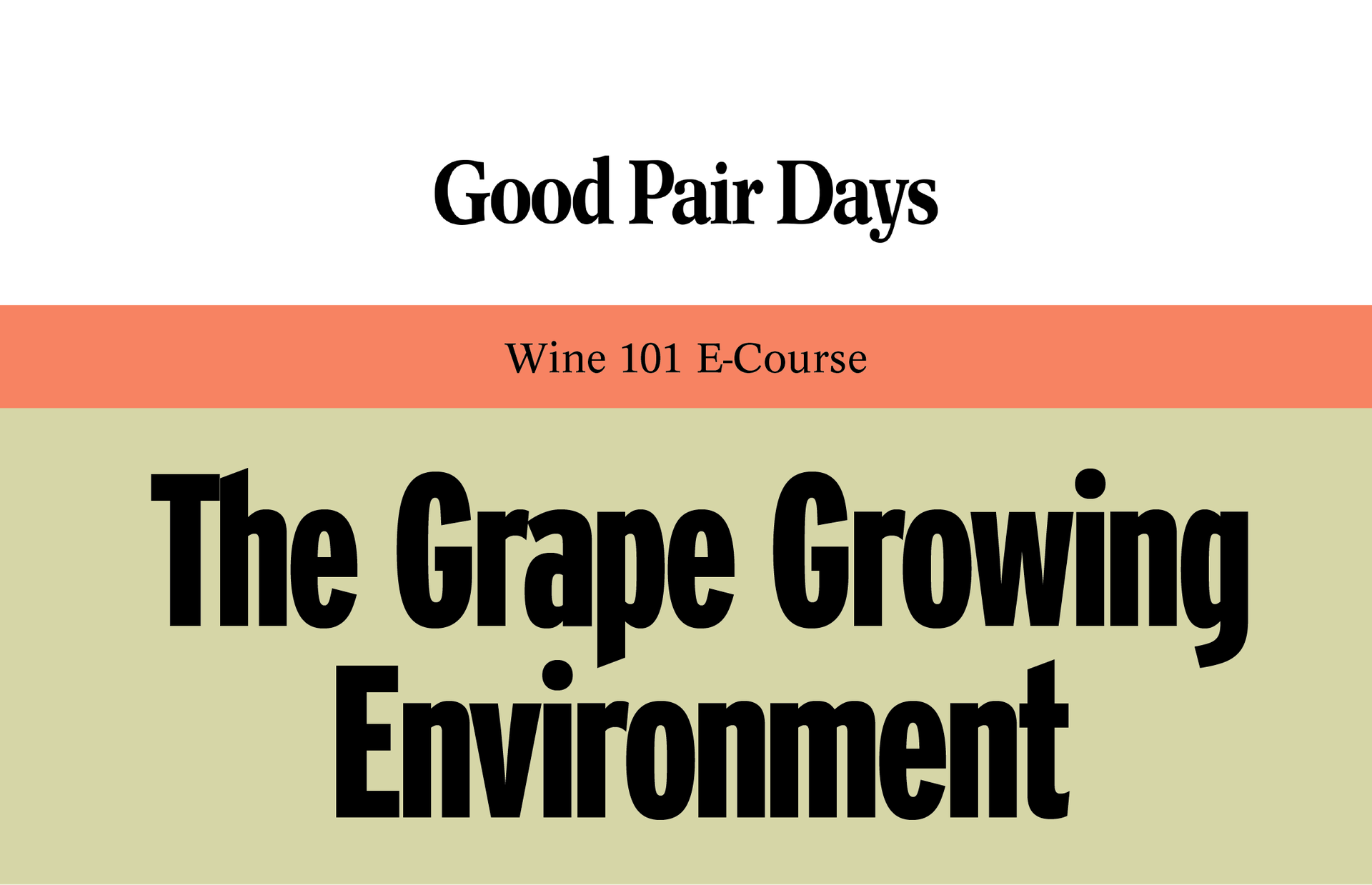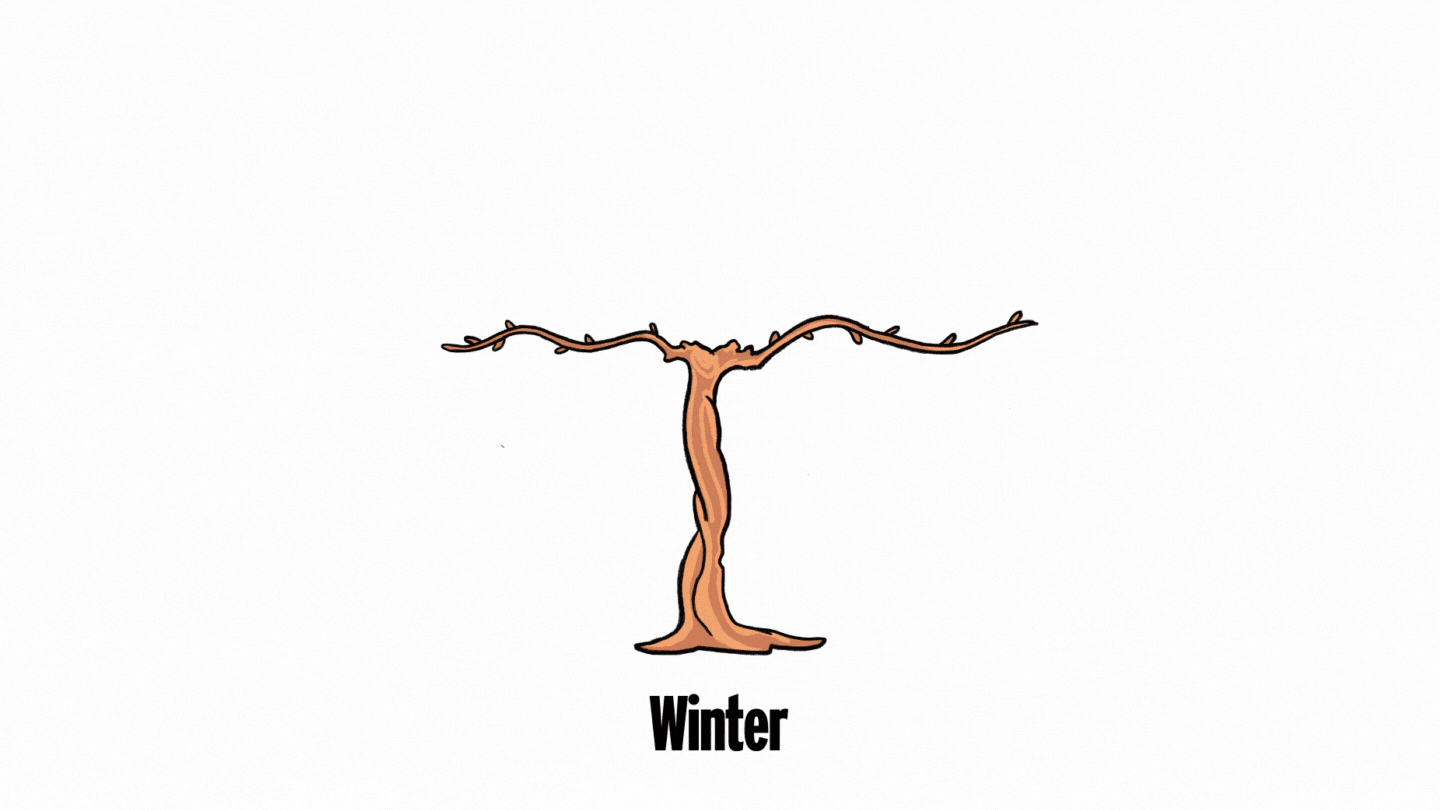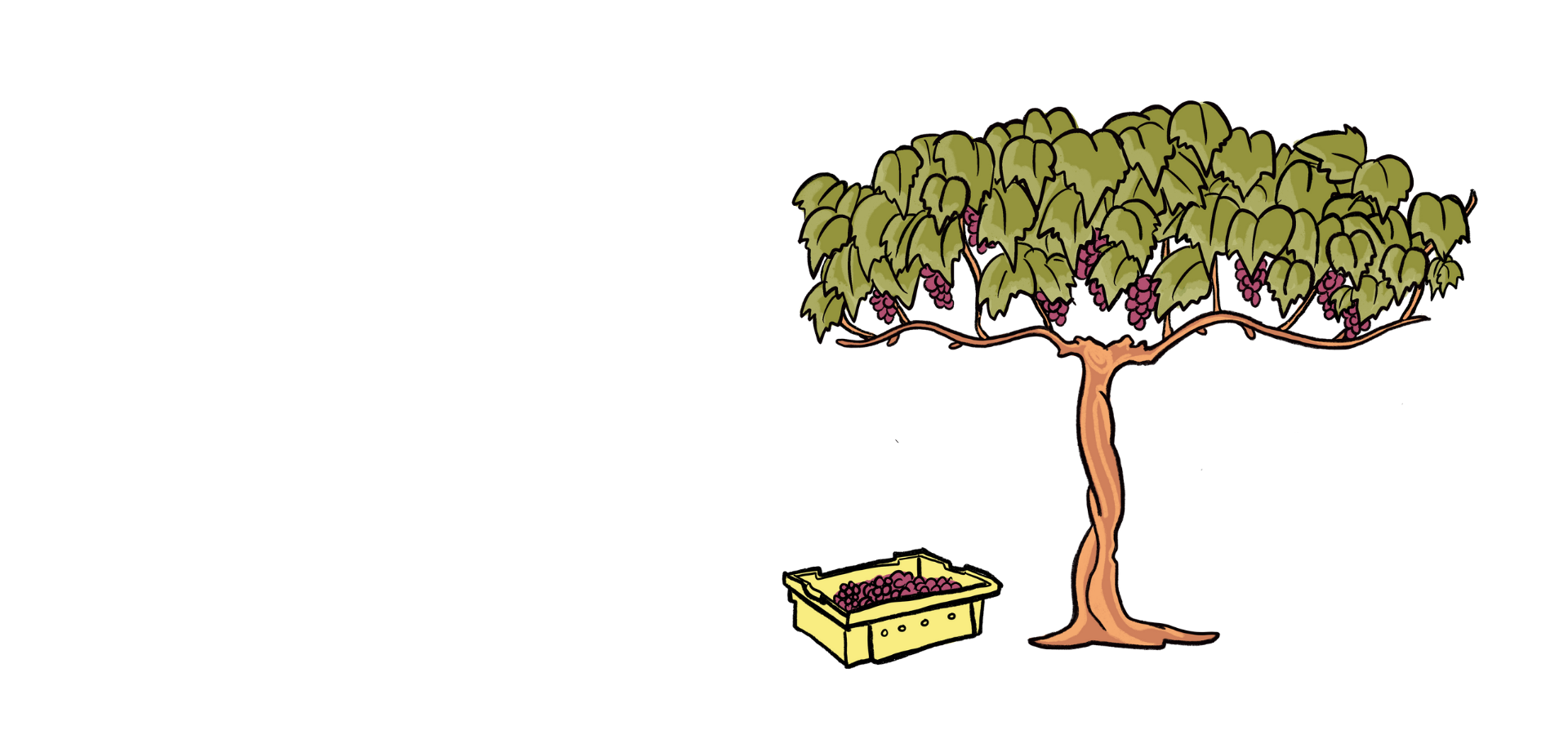

Learn everything you need to know about the wine grape growing environment and how it affects wines all around the world!


Wine grapes don't grow everywhere, they are actually pretty fickle when it comes to their favourite spots. And where they take root makes all the difference in the final style of wine that will be produced.
Today we are going to cover everything you need to know about the wine grape growing environment. Like what grapes require to grow their best, what makes certain regions better for winemaking than others, what to expect from grapes depending on the climate they are grown in, as well as the actual stages of growing grapes.
Your wine coaches,
Banjo & Alex

Like us humans, a vine requires more than just good vibes to thrive. In order for grapes to grow, a vine needs sufficient heat, sunlight, nutrients and water. Without these four essentials, the vine will die.

Heat: If the temperature falls below 10℃ it is too cold for the vine to grow. This is why vines are dormant in winter and start to perk up and begin to bud in the spring when temperatures start to rise.
Sunlight: Sunlight is required to promote photosynthesis. The more light there is, the more the vine can photosynthesize and make ripe healthy sun-kissed grapes! However, in some extreme cases, intense sunlight can cause the grapes to sunburn (resulting in bitter flavours) so some wine growers will use the leaves of the vine to shade and protect grape clusters.
Nutrients: Nutrients are an important factor to grow grapes and affect both the number of grapes produced by a single vine as well as influence the grape quality. The main nutrients a vine needs are Nitrogen, Potassium, Phosphorus, Calcium and Magnesium. The vine acquires these nutrients from the soil.
Water: The vine needs water to help with photosynthesis and to swell the grapes up to a perfect, juicy, ripe plumpness. Rainfall is the most important source of water. However in dry regions — when local laws permit — irrigation and sprinklers can be used to ensure the vine receives sufficient water.

In general, year-round weather conditions are referred to as the climate. Winemakers know that wine grapes grow best in climates that aren’t too tropical, too arid or too freezing! Most suitable climates are found between 30° – 50° latitudes, both north and south. This means yay for Australia, Argentina, South Africa in the Southern hemisphere, and of course places like the USA, France, Italy, Greece etc in the Northern Hemisphere.
Cool, dry climates produce crisp, light wines with bright fruit flavours, whereas warm climates lend themselves to bigger, bolder wines, soft in acidity with lush fruit flavours.

Cool Climate
Regions with an average growing season temperature below 16.5℃ are generally classified as cool climates. These would be regions such as Mosel (Germany), Niagara Peninsula (Canada), Tasmania (Australia), and Champagne (France).
Wines from cooler climates tend to be fresher with higher acidity, lower alcohol, lighter in body and focused on clean pure flavours. Some famous grapes and styles that perform particularly well are Riesling, Cabernet Franc, crisp Chardonnay styles (such as Chablis), elegant Pinot Noir, and also some of the best Sparkling wine styles!
Moderate Climate
Moderate climates include regions with an average growing season temperature between 16.5℃ and 21℃. These include regions like such as Oregon (USA), Adelaide Hills (SA, Australia), Margaret River (WA, Australia), Bordeaux (France) and Piedmont (Italy), and the Central Valley (Chile).
Moderate climates have more heat to grow certain grape types that cooler regions are too cold to fully ripen. They often produce wines that are ripe, juicy and medium in weight. Grapes that perform well in moderate climates include Syrah, Sauvignon Blanc, Cabernet Sauvignon and Merlot.
Warm Climate
Warm climate regions generally have an average growing season temperature above 21℃ such as the Barossa Valley (SA, Australia) Napa Valley (USA) Mendoza (Argentina), and regions in Southern Italy like Sicily and Puglia.
Warmer conditions often lead to the boldest and fullest bodied wines. They often have riper fruit flavours (instead of clean or crunchy fruits, more developed and sometimes even jammy), higher alcohol, softer acidity, and a fuller mouthfeel.
Grapes like Nero d'Avola, Grenache, Malbec, Primitivo and Viognier do well here, however Cabernet Sauvignon, Chardonnay and Shiraz also have famous and well-loved warm climate expressions.

Beyond the overarching climate of a region location, the exact planting of a vineyard is a highly considered thing and there are a few factors at play like soil type, drainage and weather conditions, as well as site-specific climatic factors such as altitude, latitude, aspect and proximity to large bodies of water.
Altitude: The temperature becomes cooler as altitude increases.
Latitude: Temperatures are warmer nearer to the equator and cooler nearer to the North and South Poles.
Aspect/Slope: Vines on a slope facing the sun get more heat and light. In the Northern hemisphere this means that south-facing slopes get more sunlight, whereas in the Southern hemisphere, north-facing slopes will get the most sunlight.
Effects from Bodies of Water: Cold ocean currents can have a cooling effect on coastal regions (such as in South Africa). Warm ocean currents can have the opposite effect (such as in Bordeaux). In other areas with close proximity to the ocean, lakes, or rivers, a temperature moderating effect can occur. Water can moderate temperatures during the night and day, providing cooling breezes during the day, and temperature moderating warmth in the evenings.

Growing grapes is full of interesting quirks, amazing skills, knowing when to let Mother Nature take the lead, and age-old techniques which keep that sense of wonder alive. But in general, the life cycle of the vine can be broken down into several key stages during the year.

Winter: The grapevine, like most summer fruit-bearing plants, lies dormant over winter and has shed all its leaves. The roots are working hard to source nutrients from the soil to keep the vine healthy and alive during the cold months. At this time, pruning is undertaken - the cutting of the previous year's canes (small vine shoots) in order to set the availability of shoots for the coming season.
Spring: As things warm up and spring comes, leaves and buds start to reappear and the vine comes to life! Small shoots will come off the main trunk and small flower buds will pop up along the vines - these are what will become grape bunches.
Summer: When summer comes, that's when the action really starts heating up! Small bunches of grapes will appear where the flowers were. During summer an important period occurs, known as veraison - this is where the juvenile grapes begin to turn from unripe green to their true colour, whether that be yellow, pink, blue or black. This signals flavour development and that the harvest time is approaching.

Autumn: is harvest time, with grapes ripening and sugar accumulating, it's time to pick them and get them into the winery. There's a few methods used to identify the perfect moment for harvest.
Once the grapes are picked, the vine will slowly 'calm down' and as autumn continues the leaves will brown and eventually fall.....only to start all over again!

Key Reading
1. Where Grapes Grow Well : A general overview.
2. How Grapes are Grown for Wine : More on the vine cycle and harvest.
Bonus Reading (for the keeners!)
3. Learn more about vintages and how they affect the final wine due to growing conditions.
4. Get to know some of the most famous regions and their climates.
Quiz
Ready to prove your new wine knowledge? Take the Chapter 3 How to The Grape Growing Environment Quiz! You'll earn your Chapter 3 Badge as well as 50 points by scoring 7/9 correct!
Homework
The best kind of assignment... tasting!
For today's assignment, you will practice tasting the difference between a cool climate wine and a warm climate wine! To do this, select a single grape type (like Pinot Noir, Chardonnay, Cabernet, or Syrah) but two different bottles; one from a cooler climate and the other from a warm climate.
Ask yourself questions like which wine has more acidity? Does one wine have riper fruit flavours than the other? Which wine is fuller vs. lighter in body? Any other interesting differences? And of course, which did you like better and why?

Boom. Class 3 of 8 complete. You're almost halfway, and look at all the new stuff you've already learned!
We're especially excited to hear what you learn in your tasting assignment. Many people find they start to notice they prefer specific wine styles from cooler climates than they do from warm, and vice versa! What a way to learn and level up your understanding your own taste preferences!
Until next time,
Happy Wine Learning!
Alex & Banjo
Do you know your wine personality? If your answer is no, take our quiz to find out which wines to pick up next and build your box!
Build my box





